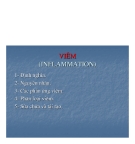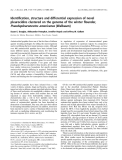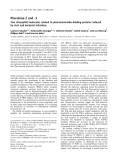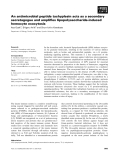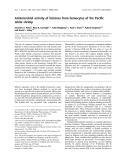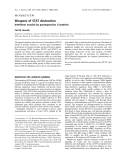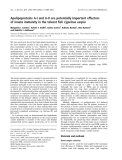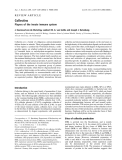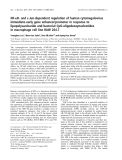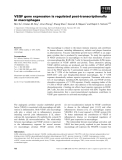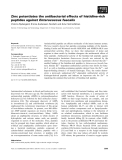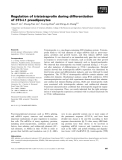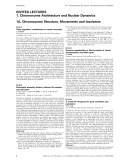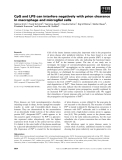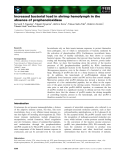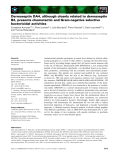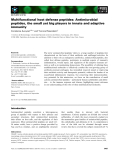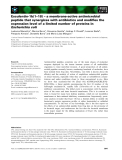
Innate immunity
-
Viêm (inflammation) là một đáp ứng bảo vệ cơ thể của hệ miễn dịch trước sự tấn công của một tác nhân bên ngoài (vi sinh vật, tác nhân hóa, lý) hoặc của tác nhân bên trong (hoại tử do thiếu máu cục bộ, bệnh tự miễn). Đây là một đáp ứng miễn dịch tự nhiên (innate immune).
 65p
65p  buddy7
buddy7
 29-06-2011
29-06-2011
 204
204
 34
34
 Download
Download
-
Antimicrobial peptides form one of the first lines of defense against invading pathogens by killing the microorganisms and/ormobilizing the host innate immune system. Although over 800 antimicrobial peptides have been isolated from many different species, especially insects, few have been reported frommarinefish. Sequenceanalysisof twogenomic clones (15.6 and 12.5 kb) from the winter flounder, Pseudopleuronectes americanus(Walbaum) resulted in the identification of multiple clustered genes for novel pleuro-cidin-like antimicrobial peptides....
 11p
11p  tumor12
tumor12
 20-04-2013
20-04-2013
 28
28
 2
2
 Download
Download
-
Drosophilais a powerful model system to study the regula-tory and effector mechanisms of innate immunity. To iden-tify molecules induced in the course of viral infection in this insect, we have developed a model based on intrathoracic injection of the picorna-like DrosophilaCvirus(DCV).We have used MALDI-TOF mass spectrometry to compare the hemolymph of DCV infected flies and control flies. By contrast with the strong humoral response triggered by injectionof bacteriaor fungal spores, we have identifiedonly one molecule induced in the hemolymph of virus infected flies....
 10p
10p  tumor12
tumor12
 20-04-2013
20-04-2013
 27
27
 3
3
 Download
Download
-
In the horseshoe crab, bacterial lipopolysaccharide (LPS) induces exocyto-sis by granular hemocytes, resulting in the secretion of various defense molecules, such as lectins and antimicrobial peptides, via a G protein-mediating signaling pathway. This response is a key component of the horseshoe crab innate immune response against infectious microorganisms. Here, we report an endogenous amplification mechanism for LPS-induced hemocytes exocytosis.
 9p
9p  fptmusic
fptmusic
 11-04-2013
11-04-2013
 44
44
 2
2
 Download
Download
-
The role of vertebrate histone proteins or histone derived peptides as innate immune effectors has only recently been appreciated. In this study, high levelsof corehistoneproteins H2A, H2B, H3 and H4 were found in hemocytes from the Pacific white shrimp,Litopenaeus vannamei. The proteins were identified by in-gel digestion, mass spectrometry ana-lysis, and homology searching. The L. vannameihistone proteins were found to be highly homologous to histones of other species.
 0p
0p  awards
awards
 05-04-2013
05-04-2013
 29
29
 1
1
 Download
Download
-
The signal transducer and activator of transcription (STAT) family of proteins function to activate gene transcription downstream of myriad cytokine and growth factor signals. The prototype STAT proteins, STAT1 and STAT2, are required for innate and adaptive antimicrobial immune responses that result from interferon signal transduction. While many viruses have evolved the ability to avoid these antiviral cytokines, the Paramyxoviruses are distinct in their abilities to interfere directly with STAT proteins. ...
 8p
8p  awards
awards
 05-04-2013
05-04-2013
 42
42
 2
2
 Download
Download
-
We have previously shown that high density lipoprotein is the most abundant protein in the carp plasma and dis-plays bactericidal activityin vitro. Therefore the aim of this study was to analyze the contribution of its principal apolipoproteins, apoA-I and apoA-II, in defense. Both apolipoproteins were isolated by a two step procedure involving affinity and gel filtration chromatography and were shown to display bactericidal and/or bacteriostatic activity in the micromolar range against Gram-positive and Gram-negative bacteria, including some fish patho-gens. ...
 7p
7p  awards
awards
 05-04-2013
05-04-2013
 39
39
 3
3
 Download
Download
-
Collectins are a family of collagenous calcium-dependent defense lectins in animals. Their polypeptide chains consist of four regions: a cysteine-rich N-terminal domain,a colla-gen-like region,ana-helical coiled-coil neck domain and a C-terminal lectin or carbohydrate-recognition domain. These polypeptide chains form trimers that may assemble into larger oligomers. The best studied family members are the mannan-binding lectin,which is secreted into the blood by the liver,and the surfactant proteins A andD,which are secreted into the pulmonary alveolar and airway lining fluid....
 21p
21p  dell39
dell39
 03-04-2013
03-04-2013
 48
48
 6
6
 Download
Download
-
Antimicrobial peptides are effector molecules of the innate immune system. We recently showed that the human anti-microbial peptidesa-defensin and LL-37 bind to glycos-aminoglycans (heparin and dermatan sulphate). Here we demonstrate the obverse, i.e. structural motifs associated with heparin affinity (cationicity, amphipaticity, and con-sensus regions)may confer antimicrobial properties to a given peptide.
 8p
8p  dell39
dell39
 03-04-2013
03-04-2013
 38
38
 3
3
 Download
Download
-
The cytomegalovirus immediate-early (CMV IE) gene enhancer/promoter regulates the expression of immediate-early gene products and initiation of CMV replication. TNF-aand lipopolysaccharide (LPS) strongly activate the promoter, possibly involving NF-jB. CpG-oligodeoxy-nucleotides (CpG-ODNs), which contain unmethylated CpG dinucleotides in the context of particular base sequences, havegainedattentionbecauseof their stimulating effects, via NF-jB, which have a strong innate immune response.
 12p
12p  dell39
dell39
 03-04-2013
03-04-2013
 31
31
 5
5
 Download
Download
-
The macrophage is critical to the innate immune response and contributes to human diseases, including inflammatory arthritis and plaque formation in atherosclerosis. Vascular endothelial growth factor (VEGF) is an angio-genic cytokine that is produced by macrophages.
 14p
14p  dell39
dell39
 27-03-2013
27-03-2013
 41
41
 4
4
 Download
Download
-
Antimicrobial peptides are effector molecules of the innate immune system. We have recently shown that peptides containing multiples of the heparin-binding Cardin and Weintraub motifs AKKARA and ARKKAAKA exert antimicrobial activities. Here, we show that replacement of lysine and arginine in these motifs by histidine abrogates the antibacterial effects of these peptides.
 8p
8p  inspiron33
inspiron33
 26-03-2013
26-03-2013
 49
49
 4
4
 Download
Download
-
Tristetraprolin is a zinc-finger-containing RNA-binding protein. Tristetra-prolin binds to AU-rich elements of target mRNAs such as proto-onco-genes, cytokines and growth factors, and then induces mRNA rapid degradation. It was observed as an immediate-early gene that was induced in response to several kinds of stimulus, such as insulin and other growth factors and stimulators of innate immunity such as lipopolysaccharides.
 12p
12p  galaxyss3
galaxyss3
 21-03-2013
21-03-2013
 37
37
 5
5
 Download
Download
-
The innate immune system has provided an excellent model for study-ing complex regulatory networks at the levels of signal transduction and transcription. Virus infection of mammalian cells triggers the coor-dinate activation of multiple signaling pathways leading to the activa-tion of specific sets of transcription factors that assemble on the interferon-b (IFN-b) gene enhancer to form an enhanceosome.
 61p
61p  galaxyss3
galaxyss3
 07-03-2013
07-03-2013
 47
47
 5
5
 Download
Download
-
Cells of the innate immune system play important roles in the progression of prion disease after peripheral infection. It has been foundin vivo and in vitro that the expression of the cellular prion protein (PrP c ) is up-regu-lated on stimulation of immune cells, also indicating the functional impor-tance of PrP c in the immune system.
 11p
11p  media19
media19
 05-03-2013
05-03-2013
 26
26
 3
3
 Download
Download
-
Toll-like receptors and RNA helicase family members [retinoic acid-inducible gene I (RIG-I) and melanoma differentiation associated gene-5 (MDA5)] play important roles in the induction of interferon-bas a major event in innate immune responses after virus infection. TRIF (adaptor pro-tein of Toll-like receptor 3)-mediated and Cardif (adaptor protein of RIG-I or MDA5)-mediated signaling pathways contribute rapid induction of interferon-bthrough the activation of interferon regulatory factor-3 (IRF-3)....
 16p
16p  media19
media19
 04-03-2013
04-03-2013
 39
39
 3
3
 Download
Download
-
Invertebrates rely on their innate immune responses to protect themselves from pathogens, one of which is melanization of bacteria mediated by the activation of phenoloxidase (PO). Furthermore, invertebrate hemo-lymph, even that of healthy individuals, has been shown to contain bacterial species.
 9p
9p  vinaphone15
vinaphone15
 25-02-2013
25-02-2013
 45
45
 2
2
 Download
Download
-
Antimicrobial peptides participate in innate host defense by directly elimi-nating pathogens as a result of their ability to damage the microbial mem-brane and by providing danger signals that will recruit innate immune cells to the site of infection. Dermaseptin DA4 (DRS-DA4), a new antimicrobial peptide of the dermaseptin superfamily, was identified based on its chemo-tactic properties, contrasting with the currently used microbicidal proper-ties assessment.
 14p
14p  viettel02
viettel02
 20-02-2013
20-02-2013
 39
39
 3
3
 Download
Download
-
The term ‘antimicrobial peptides’ refers to a large number of peptides first characterized on the basis of their antibiotic and antifungal activities. In addition to their role as endogenous antibiotics, antimicrobial peptides, also called host defense peptides, participate in multiple aspects of immunity (inflammation, wound repair, and regulation of the adaptive immune sys-tem) as well as in maintaining homeostasis.
 12p
12p  viettel02
viettel02
 20-02-2013
20-02-2013
 51
51
 3
3
 Download
Download
-
Antimicrobial peptides constitute one of the main classes of molecular weapons deployed by the innate immune system of all multicellular organisms to resist microbial invasion. A good proportion of all antimi-crobial peptides currently known, numbering hundreds of molecules, have been isolated from frog skin.
 18p
18p  viettel02
viettel02
 20-02-2013
20-02-2013
 32
32
 3
3
 Download
Download
CHỦ ĐỀ BẠN MUỐN TÌM








